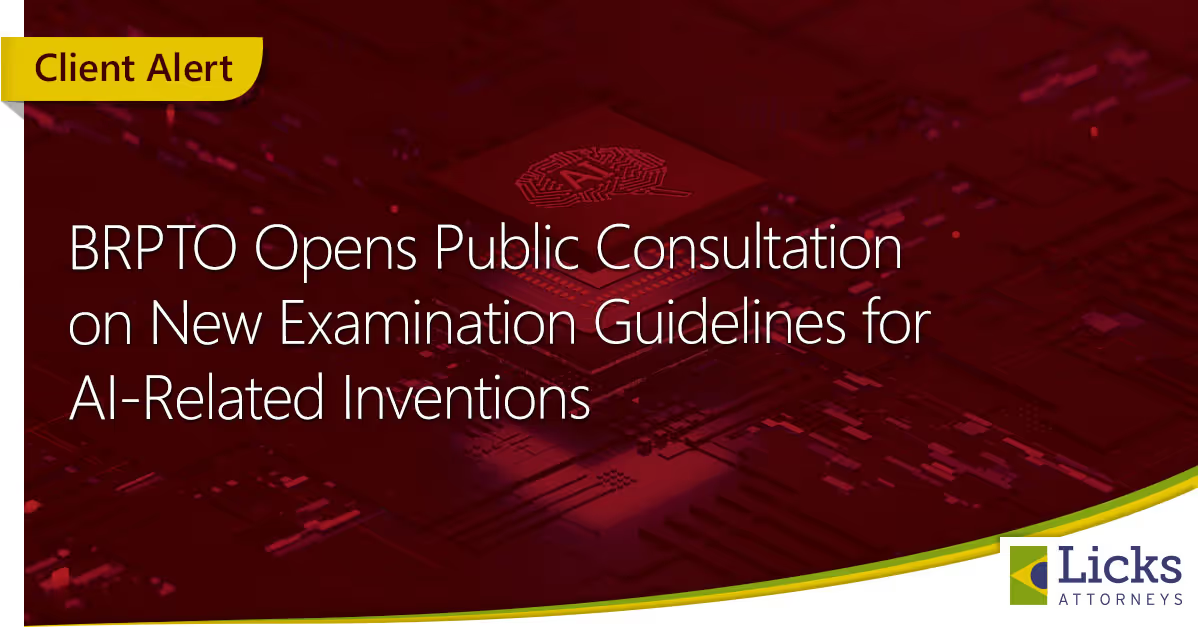
About Us
Expertise
PRACTICE AREAS
Publication
Careers
APplication Process
Join Our Team
August 18, 2025

The Brazilian Patent and Trademark Office (BRPTO) has published, in the Federal Official Gazette #155, dated August 18, 2025, the announcement of Public Consultation #3/2025, concerning the Examination Guidelines for Patent Applications involving technologies related to Artificial Intelligence (AI). Contributions to the proposed text may be submitted to the BRPTO within 60 days, i.e., by October 17.
The draft divides AI-related inventions into three main categories:
Regardless of the category, an AI-related invention must:
Thus, claims directed solely to AI models or techniques, without application to a technical field, as well as datasets used for training, testing, or validating AI, will not be accepted, as they infringe Article 10, item I of the Brazilian Patent Statute.
However, processes involving mathematical methods may be accepted, provided they result in technical effects and do not fall under the other prohibitions of Article 10 of the Brazilian Patent Statute.
BRPTO also establishes that inventions autonomously generated by AI, without any human intervention, are not eligible for protection, as per Article 6 of the Brazilian Patent Statute, which requires that the authorship of an invention be attributed to a natural person. This reinforces the position previously expressed by BRPTO in Opinion of the Specialized Federal Attorney’s Office #00024/2022.
The proposal provides that AI-based inventions, as well as AI models and techniques implemented by software, must be described in accordance with the parameters already defined in the Examination Guidelines for Computer-Implemented Inventions (CII), established by BRPTO/PR Ordinance #411/2020. Accordingly, software programs themselves continue not to be considered inventions.
Regarding sufficiency of disclosure, the draft requires that the specification include all technical details necessary for a person skilled in the art to reproduce the invention without undue experimentation. For AI models or techniques, this may include, for example, specifying the types of data collected so that a temperature control system for household refrigerators can automatically adjust compressor operation. For AI-based inventions, it may also be necessary to describe the dataset used, the clear correlation between input data and AI-generated outputs, the data processing applied, the algorithms and parameters used in the model, the training techniques, model validation and evaluation, and interaction with other technical components.
The technical application must be clearly indicated at the beginning of the claim, as illustrated by the following examples: “Method for recognizing handwritten characters using support vector machines, characterized in that...” or “Facial recognition method using neural networks, characterized in that...”.
The draft allows changing the claim category that were originally directed to an AI model and deemed inadequate under Article 25 of the Brazilian Patent Statute to be redrafted, without violating Article 32 of the Brazilian Patent Statute, provided they include technical features that use AI to solve a technical problem.
Claims directed solely to the AI model or technique itself, such as those involving neural networks, genetic algorithms, training methods and data, regression techniques, and others, are prohibited.
The draft also outlines situations to be considered in assessing non-obviousness, including the mere use of AI to automate processes, simple combinations of AI techniques, substitution of models or techniques with equivalents, parameter adjustments or optimizations, and cases where the invention results from synergy between hardware and AI algorithms.
The draft of the New Examination Guidelines for AI-Related Inventions is available in Portuguese here.
Should you have any questions regarding this new proposal or require further assistance in this regard, please do not hesitate to contact us by e-mail at info@lickslegal.com.